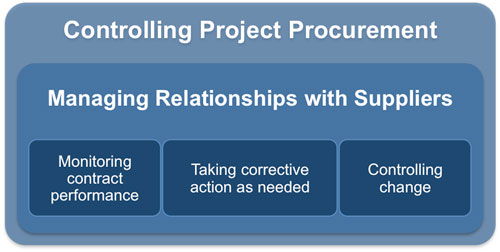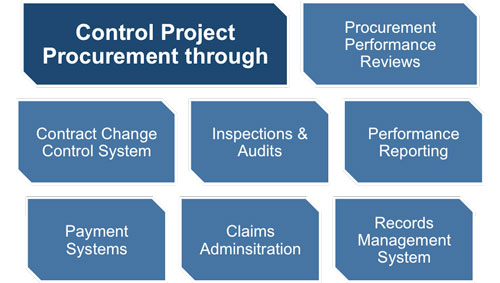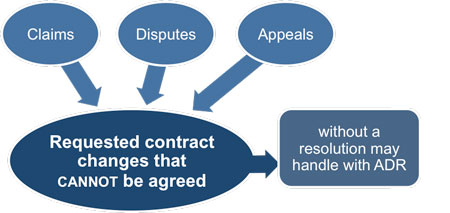Managing Supplier Relationships
This step involves managing relationships with suppliers, monitoring contract performance, taking corrective actions if required, and controlling change. This is the most time consuming of the supplier management processes as far as the project management team is concerned as it covers monitoring the supplier's performance against the terms specified in the contract.
 |
The project management team needs to keep in mind the legal implications of any actions they take when dealing with the supplier. If any changes are required to the work the supplier is doing then this may not be covered under the contract terms and conditions, or the statement of work (SOW). If this is the case then the contract may need to be renegotiated.
Any changes, whether or not they require the contract to be amended need to go through to the project change control process and incorporated into the project plan. During this process, the project manager needs to monitor progress against the procurement plan:
1) Are the goods or services being delivered on time?
2) Is the quality as specified in the contract?
3) Are the conditions of the contract being met?
4) Is the relationship being properly managed?
If the organization has a purchasing department then it may be a good idea to have someone seconded from it to the project, specifically to handle contract administration, particularly if the project is dealing with multiple suppliers.
 |
You will need a contract change control system for processing contract change requests in cases where the contract needs to be modified to reflect the evolving needs of the project. It includes a description of the process and information about how changes will be recorded and disputes resolved as well as specifying the authority levels necessary for authorizing changes.
Requested changes to the contract that cannot be agreed are called claims, disputes, or appeals. These are documented, processed, monitored, and managed throughout the contract life cycle, usually in accordance with the terms of the contract.
 |
If the parties themselves do not resolve a claim, it may have to be handled in accordance with alternative dispute resolution (ADR) typically following procedures established in the contract.
Procurement documentation also includes any supplier-developed technical documentation and other work performance information such as: deliverables, supplier performance reports, warranties, financial documents including invoices & payment records, and results of contract-related inspections.
Seller performance evaluation documentation rates how well the supplier has performed and can be used as input to decisions about performance bonuses and penalties, as well as whether or not to use their services again on future projects.
Requirements for formal closure are usually defined in the terms and conditions of the contract and are included in the procurement plan. This output is simply the formal notification from the customer that the contract has been completed.
The closure of a contract can occur in any phase of a multi-phase project if its the term is only be applicable to a given phase. Contracts that are applicable to a specific phase will have their particular procedures for contract closure included in the contract terms and conditions. If at the closure of a contract there are unresolved claims the buying-in process will detail when and how litigation will be handled.
In some instances closure of a contract may have to be earlier than planned. Any project contract or agreement needs to specify in a terminations clause the parties' responsibilities and rights in the event of early termination. This special type of procurement closure can occur from: mutual agreement of both parties, default of one party, or for convenience of the customer (as long as provision is made in the contract).
Early termination can be for the whole contract or just a particular section. It is common practice that the purchaser will have to compensate the supplier as defined in the contract for any work-in-progress (WIP) that has been undertaken.
This is especially important if the project is using teaming agreements where two or more organizations form a partnership or joint venture for the contract. Within the contract there are clear definitions of customer-supplier roles and responsibilities for each party. Many outsourcing specialists will have their own teaming agreement templates.
You may also be interested in:
Managing Project Costs | Estimating Project Costs | Calculating the Total Project Budget | Monitoring Project Expenditure | Buying-in Goods and Services | Managing Project Suppliers | Planning Contract Management | Understanding Different Contract Options | Managing Supplier Relationships.
|
|


